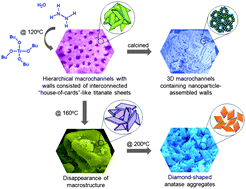Hierarchical macrochanneled layered titanates with “house-of-cards”-type titanate nanosheets and their superior photocatalytic activity†
Abstract
Novel three-dimensional (3D) hierarchical macroporous–mesoporous layered titanates were synthesized by

* Corresponding authors
a
School of Chemical Engineering, University of Ulsan, Ulsan 680-749, Daehakro 93, Nam-gu, South Korea
E-mail:
ewshin@mail.ulsan.ac.kr
Fax: +82 52 259 1689
Tel: +82-52-259-2253
b Department of Materials Science and Engineering, Rutgers, The State University of New Jersey, 607 Taylor Road, Piscataway, NJ 08854, USA
c
Department of Chemistry and Chemical Biology, Rutgers, The State University of New Jersey, 610 Taylor Road, Piscataway, NJ 08854, USA
E-mail:
tasefa@rci.rutgers.edu
Fax: +1 732 4455312
Tel: +1 848 4452970
d Department of Chemical and Biochemical Engineering, Rutgers, The State University of New Jersey, 98 Brett Road, Piscataway, NJ 08854, USA
Novel three-dimensional (3D) hierarchical macroporous–mesoporous layered titanates were synthesized by

 Please wait while we load your content...
Something went wrong. Try again?
Please wait while we load your content...
Something went wrong. Try again?
T. Nguyen-Phan, E. Oh, M. Chhowalla, T. Asefa and E. W. Shin, J. Mater. Chem. A, 2013, 1, 7690 DOI: 10.1039/C3TA11383C
To request permission to reproduce material from this article, please go to the Copyright Clearance Center request page.
If you are an author contributing to an RSC publication, you do not need to request permission provided correct acknowledgement is given.
If you are the author of this article, you do not need to request permission to reproduce figures and diagrams provided correct acknowledgement is given. If you want to reproduce the whole article in a third-party publication (excluding your thesis/dissertation for which permission is not required) please go to the Copyright Clearance Center request page.
Read more about how to correctly acknowledge RSC content.
 Fetching data from CrossRef.
Fetching data from CrossRef.
This may take some time to load.
Loading related content
